Asus P5WDG2-WS: Intel 975X goes to Work
by Gary Key on December 6, 2005 12:05 AM EST- Posted in
- Motherboards
Test Setup
The Intel 975X chipset fully supports the 820, 830, and 840 dual core Pentium D processors in both stock and overclocked conditions. This chipset also supports the upcoming Presler and Cedar Mill processor range. Dual core really makes a difference in certain multi-tasking scenarios, as was demonstrated in the dual core performance preview. If you are interested in how the various chipsets perform in a real world multitasking setup, please take another look at that review.
NVIDIA SLI Performance
Although the performance does not match the newer 81.xx series of drivers, the 975X boards are still competitive with the nForce4 Intel Edition SLI setup considering the beta condition of the non-certified drivers used. We noticed some graphic anomalies with the Asus P5WDG2-WS in the benchmarks that explains the lower scores compared to the Gigabyte board.
The ability of the 975X based boards to run both ATI CrossFire and NVIDIA SLI setups is definitely a marketing plus, but until Intel licenses and NVIDIA fully certifies and sanctions SLI on the Intel platform, we can only wonder what the impact would be in the market.
Overclocking Performance
The overclocking performance graphs have been added to the standard benchmark test suite and should allow for a better comparison on the overclocking capabilities of tested boards. For more details on the specific overclocking abilities of this board, please refer to the Overclocking and Memory Stress Test section in the Basic Features section.
The Intel 975X chipset fully supports the 820, 830, and 840 dual core Pentium D processors in both stock and overclocked conditions. This chipset also supports the upcoming Presler and Cedar Mill processor range. Dual core really makes a difference in certain multi-tasking scenarios, as was demonstrated in the dual core performance preview. If you are interested in how the various chipsets perform in a real world multitasking setup, please take another look at that review.
| Performance Test Configuration | |
| Processor(s): | Intel Pentium 840EE (3.2GHz, 800FSB, Dual-Core, 2x1MB L2, HT) utilized for all tests |
| RAM: | 2 x 512MB Corsair CM2X512A-5400UL revision 1.3 Settings- DDR2-667 as noted at (CL3-2-2-8) |
| Hard Drive(s): | 2 x Maxtor MaXLine III 7L300S0 300GB 7200 RPM SATA (16MB Buffer), 1 x Maxtor MaXLine III 7L300R0 300GB 7200 RPM IDE (16MB Buffer) |
| System Platform Drivers: | Intel Chipset Software - 7.2.2.1006 |
| Video Cards: | 1 x XFX 7800GTX OC (PCI Express) for standard tests 2 x MSI 7800GTX (PCI Express) for SLI test |
| Video Drivers: | NVIDIA nForce 81.95 WHQL NVIDIA nForce 78.01 Modified for SLI test |
| Operating System(s): | Windows XP Professional SP2 |
| Motherboards: | Asus P5N32-SLI Deluxe Gigabyte GA-G1 975X Gigabyte GA-8I955X Royal |
NVIDIA SLI Performance
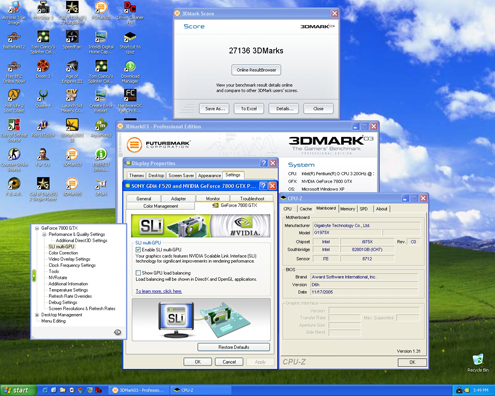
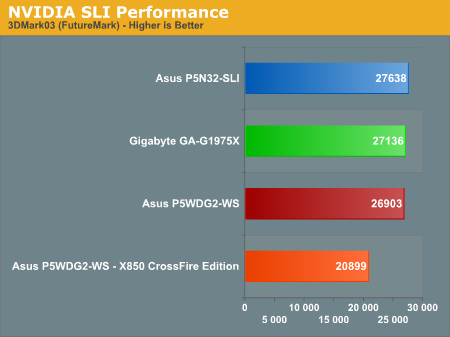
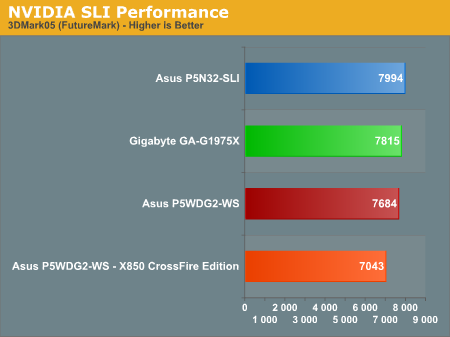
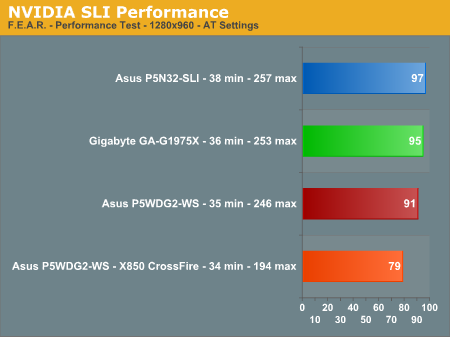
Although the performance does not match the newer 81.xx series of drivers, the 975X boards are still competitive with the nForce4 Intel Edition SLI setup considering the beta condition of the non-certified drivers used. We noticed some graphic anomalies with the Asus P5WDG2-WS in the benchmarks that explains the lower scores compared to the Gigabyte board.
The ability of the 975X based boards to run both ATI CrossFire and NVIDIA SLI setups is definitely a marketing plus, but until Intel licenses and NVIDIA fully certifies and sanctions SLI on the Intel platform, we can only wonder what the impact would be in the market.
Overclocking Performance
The overclocking performance graphs have been added to the standard benchmark test suite and should allow for a better comparison on the overclocking capabilities of tested boards. For more details on the specific overclocking abilities of this board, please refer to the Overclocking and Memory Stress Test section in the Basic Features section.

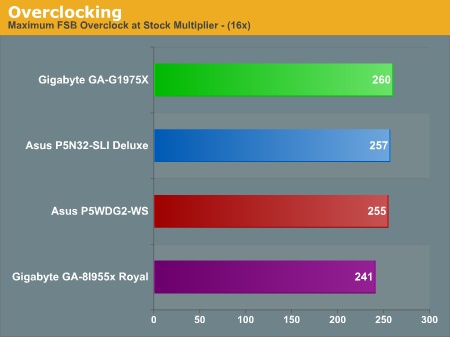










31 Comments
View All Comments
Cygni - Wednesday, December 7, 2005 - link
Workstation /= server...Overclocking isnt wacky in the worstation world at all. Picture a guy using 3dsmax everyday in his personal studio, or rendering TV streams in Maya, or doing texture work, or compiling source codes at a game studio...
Overclocking in the Workstation market is probably ALOT more common than people would think. Take overclocking that Pressler. That big of an overclock could mean whole DAYS of extra time per year that the CPU would have otherwise been spending cranking away on rendering. Thats a serious gain.
I dont think many serious servers will find a board like this one in em, to boot. Its lacking alot of features that a serious server hosting lots of users would deffinitly feel the need for... like built in SCSI, multi cpu support, RAM support over 8gig/4slot, etc.
On the other hand, this is a near perfect workstation board. High clocked RAM support for both ECC and non ECC. Non buffered memory. Both SLI and Crossfire support at 8x/8x. Plenty of SATA II plugs for cheap storage.
I took notice of the OC results and settings, and i like what i saw. :)
Cygni - Wednesday, December 7, 2005 - link
That was a reply to the poster one level up, sorry. :DThanks for taking the time to do the OC tests, however. Some people out there did like to see em.
Zebo - Tuesday, December 6, 2005 - link
If those 4.8ghz air overclocks are normal intel won't have to wait for conroe to take back enthusiasts crown. That's amazing.Leper Messiah - Tuesday, December 6, 2005 - link
Hell yeah. 4.8GHz on air with Dual core is a 20% over what an 840EE will do. And I bet that with nF4 and a DFI 5.0+ is possible. oooh. Sexay.stephenbrooks - Tuesday, December 6, 2005 - link
Yeah, I'm wondering if the Pentium D 920 might become a new "favourite" chip for them to play with :)Niv KA - Tuesday, December 6, 2005 - link
Talking about Conroe, isn't the 975X supposed to support upgradability to itxtremejack - Tuesday, December 6, 2005 - link
If you look at the chipset price guides for this month by Anand, 975x will not support ConroeGary Key - Tuesday, December 6, 2005 - link
Intel has not officially confirmed either way on the 975X to Conroe path. We have heard both a positive and negative on this but from different sources. As soon as we have a clear path it will be posted.Niv KA - Tuesday, December 6, 2005 - link
That would mean I could buy a 975X based MB with a Celeron and buy a Conroe in the summer without having to buy a new motherbord and allCalin - Tuesday, December 6, 2005 - link
When the graphs shows both min framerate and max framerate, I suggest that ordering should be done by the min framerate instead of the max framerate. Only on F.E.A.R. Performance test on the 9th page the results will change, and only for the top two boards - however, I prefer to have good consistent high framerate in the worst cases than extremely high framerate in the best conditions.Thanks